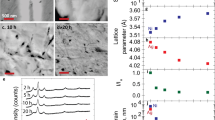Abstract
Control of the low-temperature sintering of nanosilver particles was attained by dispersing and stabilizing nanosilver particles into a paste form using the selected organic binder systems. As demonstrated by scanning electron microscopy (SEM) and thermogravimetric analysis (TGA), with the existing binder systems, undesirable premature coalescence of nanosilver particles was prevented and the metastable structure was retained until the binder burned out at relatively higher temperatures. Enhanced densification was achieved upon the binder burnout because at the relatively higher temperatures the densification mechanisms, e.g., grain-boundary or lattice diffusion, become more dominant. We propose that the onset of sintering, extent of densification, and final grain size can be controlled by either the size of the initial nanosilver particles or the binder systems with different burnout characteristics.








Similar content being viewed by others
References
M.J. Mayo: Processing of nanocrystalline ceramics from ultrafine particles. Int. Mater. Rev. 41, 85 (1996).
J.R. Groza: Nanosintering. Nanostruct. Mater. 12, 987 (1999).
J.G. Bai, Z.Z. Zhang, J.N. Calata, and G.Q. Lu: Low-temperature sintered nanoscale silver as a novel semiconductor devicemetallized substrate interconnect material. IEEE Trans. Compon. Packag. Technol. 29, 589 (2006).
J.G. Bai and G.Q. Lu: Thermomechanical reliability of lowtemperature sintered silver die-attached SiC power device assembly. IEEE Trans. Device Mater. Reliab. 6, 436 (2006).
M.P. Harmer and R.J. Brook: Fast firing±microstructural benefits. J. British Ceram. Soc. 80, 147 (1981).
R.M. German: Sintering Theory and Practice (John Wiley, New York, 1996).
P. Powen and C. Carry: From powders to sintered pieces: Forming, transformations and sintering of nanostructured ceramic oxides. Powder Technol. 128, 248 (2002).
M.N. Rahaman: Ceramic Processing and Sintering (Marcel Dekker, New York, 1995).
J. Freim, J. McKittrick, J. Katz, and K. Sickafus: Microwave sintering of nanocrystalline γ-Al2O3. Nanostruct. Mater. 4, 371 (1994).
J.R. Groza and A. Zavaliangos: Nanostructured bulk solids by field activated sintering. Rev. Adv. Mater. Sci. 5, 24 (2003).
S.W. Wang, L.D. Chen, and T. Hirai: Densification of Al2O3 powder during spark plasma sintering. J. Mater. Res. 15, 982 (2000).
G. Xu, I.K. Lloyd, Y. Carmel, T. Olorunyolemi, and O.C. Wilson: Microwave sintering of ZnO at ultra high heating rate. J. Mater. Res. 16, 2850 (2001).
S.B. Fuller, E.J. Wilhelm, and J.M. Jacobson: Ink-jet printed nanoparticle microelectromechanical systems. J. Microelectromech. Sys. 11, 54 (2002).
D.H. Napper: Polymeric Stabilization of Colloidal Dispersions (Academic Press, New York, 1983).
J.W. Choe, J.N. Calata, and G.Q. Lu: Constrained-film sintering of a gold circuit paste. J. Mater. Res. 10, 986 (1995).
Acknowledgments
This research was supported mainly by the Engineering Research Center Program of the National Science Foundation under Award Number EEC-9731677 in the Center for Power Electronics Systems at Virginia Tech.
Author information
Authors and Affiliations
Corresponding author
Rights and permissions
About this article
Cite this article
Bai, J.G., Lei, T.G., Calata, J.N. et al. Control of nanosilver sintering attained through organic binder burnout. Journal of Materials Research 22, 3494–3500 (2007). https://doi.org/10.1557/JMR.2007.0440
Received:
Accepted:
Published:
Issue Date:
DOI: https://doi.org/10.1557/JMR.2007.0440




